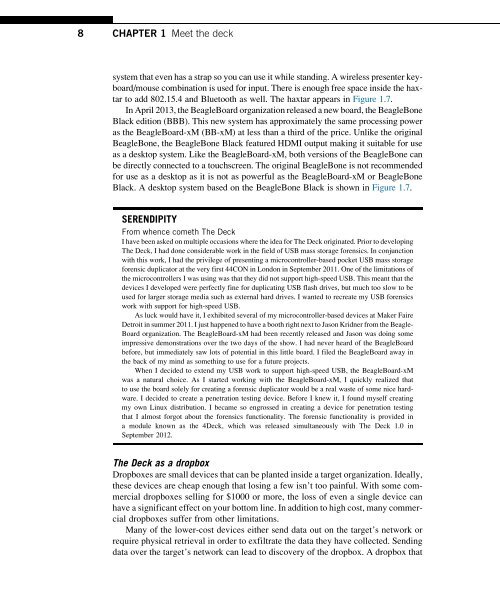Hacking_and_Penetration_Testing_with_Low_Power_Devices
Create successful ePaper yourself
Turn your PDF publications into a flip-book with our unique Google optimized e-Paper software.
8 CHAPTER 1 Meet the deck<br />
system that even has a strap so you can use it while st<strong>and</strong>ing. A wireless presenter keyboard/mouse<br />
combination is used for input. There is enough free space inside the haxtar<br />
to add 802.15.4 <strong>and</strong> Bluetooth as well. The haxtar appears in Figure 1.7.<br />
In April 2013, the BeagleBoard organization released a new board, the BeagleBone<br />
Black edition (BBB). This new system has approximately the same processing power<br />
as the BeagleBoard-xM (BB-xM) at less than a third of the price. Unlike the original<br />
BeagleBone, the BeagleBone Black featured HDMI output making it suitable for use<br />
as a desktop system. Like the BeagleBoard-xM, both versions of the BeagleBone can<br />
be directly connected to a touchscreen. The original BeagleBone is not recommended<br />
for use as a desktop as it is not as powerful as the BeagleBoard-xM or BeagleBone<br />
Black. A desktop system based on the BeagleBone Black is shown in Figure 1.7.<br />
SERENDIPITY<br />
From whence cometh The Deck<br />
I have been asked on multiple occasions where the idea for The Deck originated. Prior to developing<br />
The Deck, I had done considerable work in the field of USB mass storage forensics. In conjunction<br />
<strong>with</strong> this work, I had the privilege of presenting a microcontroller-based pocket USB mass storage<br />
forensic duplicator at the very first 44CON in London in September 2011. One of the limitations of<br />
the microcontrollers I was using was that they did not support high-speed USB. This meant that the<br />
devices I developed were perfectly fine for duplicating USB flash drives, but much too slow to be<br />
used for larger storage media such as external hard drives. I wanted to recreate my USB forensics<br />
work <strong>with</strong> support for high-speed USB.<br />
As luck would have it, I exhibited several of my microcontroller-based devices at Maker Faire<br />
Detroit in summer 2011. I just happened to have a booth right next to Jason Kridner from the Beagle-<br />
Board organization. The BeagleBoard-xM had been recently released <strong>and</strong> Jason was doing some<br />
impressive demonstrations over the two days of the show. I had never heard of the BeagleBoard<br />
before, but immediately saw lots of potential in this little board. I filed the BeagleBoard away in<br />
the back of my mind as something to use for a future projects.<br />
When I decided to extend my USB work to support high-speed USB, the BeagleBoard-xM<br />
was a natural choice. As I started working <strong>with</strong> the BeagleBoard-xM, I quickly realized that<br />
to use the board solely for creating a forensic duplicator would be a real waste of some nice hardware.<br />
I decided to create a penetration testing device. Before I knew it, I found myself creating<br />
my own Linux distribution. I became so engrossed in creating a device for penetration testing<br />
that I almost forgot about the forensics functionality. The forensic functionality is provided in<br />
a module known as the 4Deck, which was released simultaneously <strong>with</strong> The Deck 1.0 in<br />
September 2012.<br />
The Deck as a dropbox<br />
Dropboxes are small devices that can be planted inside a target organization. Ideally,<br />
these devices are cheap enough that losing a few isn’t too painful. With some commercial<br />
dropboxes selling for $1000 or more, the loss of even a single device can<br />
have a significant effect on your bottom line. In addition to high cost, many commercial<br />
dropboxes suffer from other limitations.<br />
Many of the lower-cost devices either send data out on the target’s network or<br />
require physical retrieval in order to exfiltrate the data they have collected. Sending<br />
data over the target’s network can lead to discovery of the dropbox. A dropbox that


